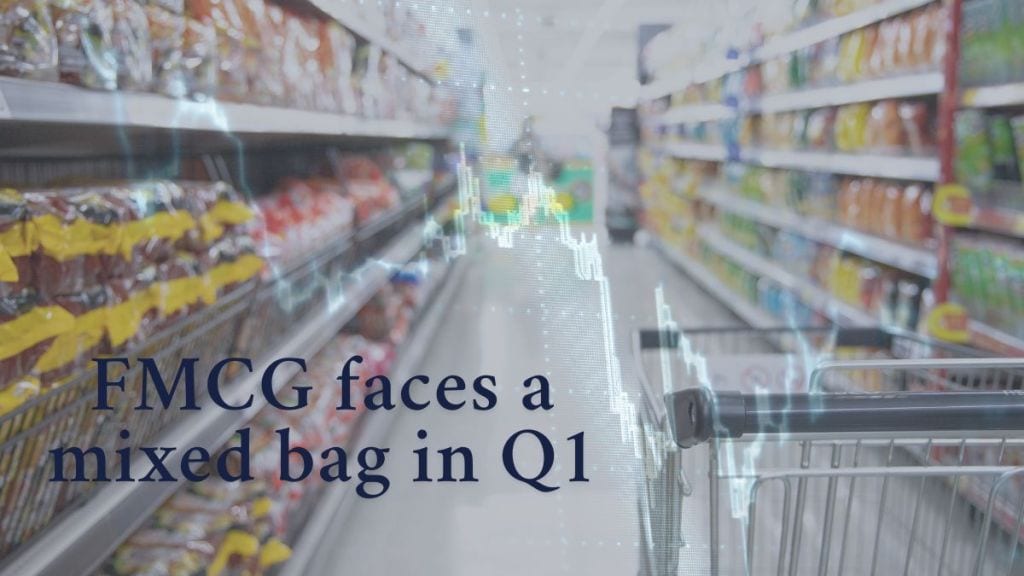India’s consumer goods sector is poised for a modest revival in the first quarter of FY26, driven by improvement in rural demand and easing raw metal prices. However, subdued urban consumption and margin pressure is expected to continue to cloud the earnings outlook for most players in the segment, making it the fourth consecutive quarter of subdued profitability.
According to brokerage firms and analysts, sectoral revenue is expected to grow between 6-8 per cent on-year in Q1FY26, with volume growth slowly replacing price hikes as the primary driver. While Emkay Global predicted 8 per cent on-year venue growth in Q1 for its coverage companies, Nomura pegged overall sales growth at 6.7 per cent YoY with Marico, Bitannia, Tata Consumer expected to lead with double-digit gains. Meanwhile, Nuvama estimated that its coverage universe will post revenue and volume growth of 6 per cent and 4 per cent in Q1FY26.
Rural green shoots vs urban gloom
Demand slump continues in Q1FY26, with weak seasonality impacting growth recovery. According to experts, the demand revival is being led primarily by rural India buoyed by a moderating food inflation and expectation of a bumper Kharif (monsoon) crop on the back of above-normal monsoon forecast. In contrast, urban demand is expected to remain weak but stable in Q1FY26, impacted by low wage growth and higher rental inflation. Nomura, however, said that with overall inflation expected to moderate going forward, a boost from the lowering of income tax in this year’s budget, and a repo rate cut, urban demand is expected to recover gradually.
While positive on a strong rural demand, Nuvama said that urban slowdown (weak kirana and modern trade) is expected to continue in H1FY26 due to low wage growth and higher rentals.
Furthermore, volume growth across staples is expected to be similar to that in Q4, with select players seeing moderate improvement and some facing volume pressure. Players like Marico, Britannia, and Hindustan Unilever are showing early signs of recovery. According to Nomura, sector-wide sales growth is forecasted at around 6.7 per cent YoY, above the eight-quarter average of 4.6 per cent, driven primarily by volumes rather than pricing.
Summer portfolio takes a hit
The summer season was broadly weak across the sector due to unseasonal rains and heatwaves in the base with May being the weakest. Expecting strong demand, many companies and retailers had built up extra inventory by March, but much of it remained unsold. This, Nuvama said, led to companies cutting production of summer products such as ACs, beverages and talcum powders by up to 20 per cent due to weak sales and excess inventory.
Out-of-home consumption is seeing weak sales, especially for products like soft drinks and ready-to-eat snacks sold through kirana stores and quick commerce platforms. Ice cream sales too dropped by up to 10 per cent, mainly in southern and western India, Nuvama stated.
All summer categories shall report muted volume growth; for instance, Varun Beverages’s India business volumes will decrease 4 per cent YoY while Emami’s domestic business volumes shall decline 5 per cent YoY, the brokerage firm said.
Nomura added, “We expect summer portfolio across companies to be impacted on the back of early monsoon. Companies with categories like juices, soft-drinks, water, ice-cream, cooling hair oils can see the most impact, as we expect these categories to witness YoY decline in sales.”
Input cost relief delayed by old inventory
For the past few quarters, commodities such as tea, coffee and palm oil were inflationary, but from Q1FY26 these commodities have started easing off. Palm oil prices have fallen 13 per cent QoQ. Also, PFAD costs are high, but likely to ease off from Q2FY26.
While input prices such as palm oil, coffee and crude have begun to moderate, the benefit will likely start flowing into company margins only from Q2FY26 onwards. In Q1, brokerages said, most companies are still consuming high-cost inventory, keeping gross margins under pressure.
EBITDA margins are expected to contract or stay flat for a majority of firms. Emkay noted that margin pressure is particularly intense for HUL, Nestlé, Marico, Emami, and Honasa Consumer. Only Britannia and a few others are projected to post meaningful EBITDA growth this quarter, it added.
Competitive promotions, soft pricing
Now with the prices of raw materials starting to moderate, new price hikes have largely paused. “Carry forward pricing will continue, but will taper off gradually going forward,” Nomura said while maintaining that Marico and Britannia are expected to see new or the highest increase in price hikes with limited volume backlash demonstrating superior pricing power.
However, competitive intensity, it added, remained moderate as companies are still coming out of margin pressure seen earlier due to high raw material prices. While softening raw material prices could invite competition from unorganised players, it is still some quarters away. Nomura said, “We believe companies with strong brands, pricing power and higher saliency of premium portfolio should be relatively less impacted in that scenario.”
Company outlook: Leaders and laggards
Top gainers this quarter are expected to include:
Britannia: Expect volume growth (4.5 per cent YoY) to see some improvement despite 6 per cent YoY price hike taken in Q4FY25; leading to 10 per cent YoY revenue growth.
Marico: Marico is expected to continue to materially outperform its peers on revenue growth (20 per cent YoY) supported by superior pricing power. Volume growth is expected at 7 per cent.
Meanwhile, Tata Consumer and Nestlé will benefit from early inventory moves and a diverse portfolio. In contrast, companies like Colgate, Dabur, Emami, and Varun Beverages may struggle due to category-specific challenges and weaker summer sales.

